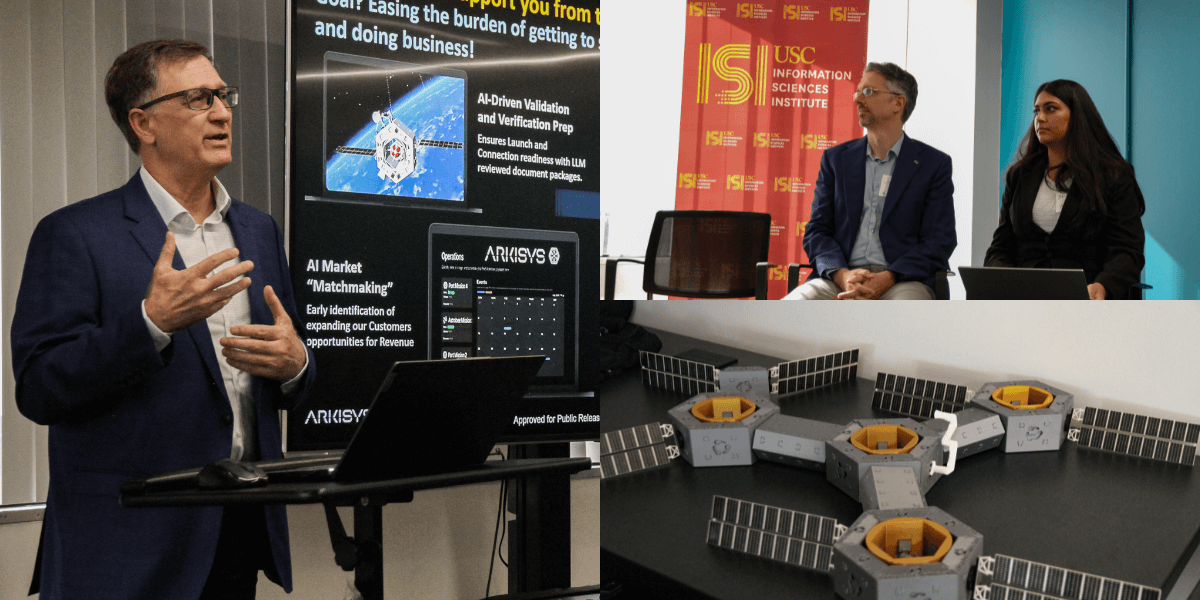Space Robotics Platform Astrobee Set for Commercial Transition for ISS Operations

A free-flying robotic platform that has enabled groundbreaking research aboard the International Space Station (ISS) is preparing for a return to flight under new commercial management, according to David Barnhart, Research Professor at USC Viterbi and Director of USC’s Space Engineering Research Center (SERC) co-located at USC Viterbi’s Information Sciences Center (ISI).
Astrobee, NASA’s cube-shaped autonomous robot that operates inside the ISS, is set to resume operations in early 2026 under the stewardship of Arkisys, founded by Barnhart, a space logistics company that has been selected as the platform’s sustainer and maintainer. The announcement came during an LA Tech Week panel hosted at ISI, on October 13, 2025.
The next era of orbital innovation?
Astrobee is being used to test everything from autonomous navigation and computer vision to classroom coding and commercial servicing technology in zero-g.

Photo credit: ISI/USC
The panel highlighted Astrobee’s growing role as a space-based laboratory for rapid, real-world experimentation. Jonathan Barlow, Astrobee Project Manager introduced the platform with a simple summary: “It’s a robot in space.” He continued, “It has propulsion, it has cameras, it has computing power, and it’s flying around inside the space station.”
Originally inspired by a 1977 Star Wars scene showing Luke Skywalker training with a floating droid, Astrobee evolved from an earlier platform called SPHERES, created by an MIT professor and his students. The robot uses air propulsion to fly freely within the station’s microgravity environment and features cameras, a touchscreen display, laser pointers, and a three-degree-of-freedom perching arm.
Path forward
Arkisys aims to democratize access to the platform, working through the ISS National Laboratory to facilitate partnerships with international space agencies and commercial users.
The company is developing a three-tier service model: software-only experiments, software combined with existing hardware payloads already aboard the ISS, and eventually new hardware launches. Ground testing facilities will be available at NASA Ames Research Center, USC, and Arkisys’s own facility in Los Alamitos, California.
Experiments in progress
Among the experiments presented was Zero Robotics, a STEM initiative from MIT that gives middle and high school students the opportunity to write code that runs aboard the ISS. “It’s not just a simulation,” said Alissa Chavalithumrong. “The code goes through flight readiness and is uploaded to the ISS. They’re literally writing code for space.”
Kirk Hovell of Obruta Space Solutions shared details of AstroSee, a real-time computer vision system being tested on Astrobee to support autonomous docking. “We’re trying to create an autonomy layer for docking that helps spacecraft align and navigate without relying on Earth,” he said.
Austin Morris of Kall Morris Inc. described REACCH, a robotics project exploring how tentacle-like arms could be used for future debris capture and spacecraft handling. “We’re taking inspiration from biology to build something adaptive and precise,” he said. “Astrobee gives us a microgravity test environment to learn what works.”
Jaxson Hill, a Ph.D. student at USC Viterbi, presented progress on CLINGERS, a genderless docking prototype developed at SERC. “We’re exploring how small, cooperative spacecraft could latch onto surfaces or each other in orbit,” he said. “Astrobee helps us validate those ideas in the actual environment.”
Yashvi Deliwala, Astrobee Mission Manager at Arkisys (and USC grad), explained what it takes to get an experiment onto the platform: from proposal development and flight readiness to software integration and coordination with NASA.
A platform for discovery
“Astrobee gives us a rare chance to test autonomy in a true microgravity environment,” said Barnhart. “It’s a flying robot on the space station. That makes it incredibly rare and valuable for universities and companies nationally and across the world.”
From education to commercialization, Astrobee is becoming more than a research tool. It is a stepping stone toward practical systems that can operate independently in orbit. While each experiment served a different purpose, the underlying theme was clear: access to real hardware in space accelerates meaningful progress.
Learn more about ISI’s Tech Week programming, including other sessions and highlights, here.
Published on October 15th, 2025
Last updated on October 20th, 2025